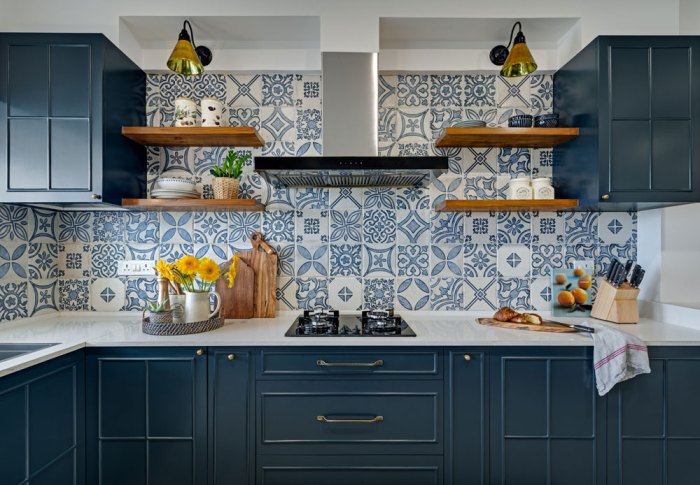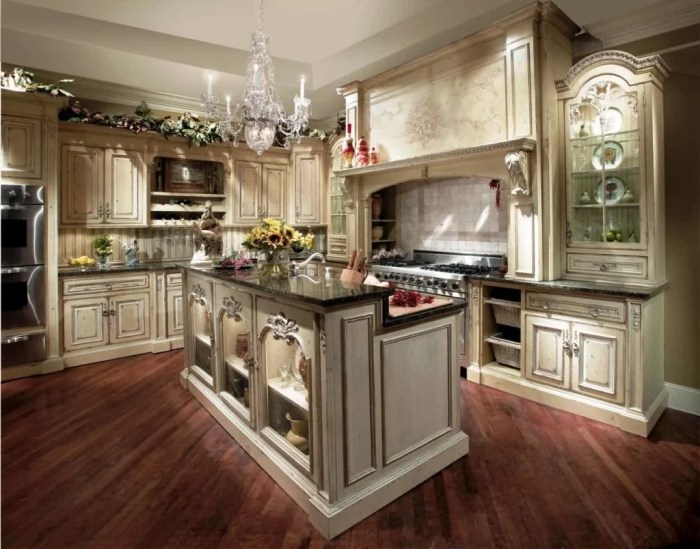Incorporating Mediterranean Elements in Your Modular Kitchen is an exciting endeavor that can transform your cooking space into a warm, inviting, and stylish haven. By blending earthy tones, natural materials, architectural details, traditional patterns, and a seamless connection to the outdoors, you can create a kitchen that exudes the essence of the Mediterranean.
From the sun-kissed hues of the Mediterranean landscape to the intricate patterns and textures found in traditional architecture, this design approach brings a touch of timeless elegance and laid-back luxury to your home.
Mediterranean Color Palette
When designing a Mediterranean-style kitchen, color plays a pivotal role in capturing the warmth and vibrancy of the region. Earthy tones, inspired by the sun-kissed landscapes, create a welcoming and inviting atmosphere.
For walls, consider shades of warm beige, terracotta, or olive green. These hues evoke the colors of sun-drenched fields and olive groves, bringing a touch of nature indoors. Alternatively, opt for soft white or cream as a backdrop to showcase colorful tiles and accents.
Tile Hues
Mediterranean kitchens often feature vibrant tiles that add a splash of color and pattern. Look for tiles in shades of turquoise, azure, or cobalt blue, reminiscent of the sparkling Mediterranean Sea. These hues create a sense of freshness and openness, bringing the outdoors in.
Terracotta tiles, with their warm, earthy tones, are another popular choice. They evoke the rustic charm of traditional Mediterranean homes and pair well with natural wood accents.
Countertop Materials
For countertops, natural materials such as marble, granite, or limestone are ideal. These materials exude elegance and durability, while their natural variations in color and texture add character to the space.
Choose countertops in shades of beige, brown, or gray to complement the warm tones of the kitchen. White marble countertops can create a clean and sophisticated look, while granite offers a more durable option with a wide range of color choices.
Psychological Effects of Colors
The colors used in a Mediterranean kitchen have a profound impact on the ambiance of the space. Warm, earthy tones promote a sense of comfort and relaxation, making the kitchen a welcoming gathering place.
Blue hues, associated with water and the sky, create a calming and serene atmosphere. They can help reduce stress and promote a sense of tranquility, making the kitchen a perfect spot to unwind.
Natural Materials and Textures
Mediterranean-style kitchens embrace the beauty of natural materials to create a warm, inviting, and authentic atmosphere. Wood, stone, and terracotta are commonly used to add texture, depth, and a connection to the outdoors.
Wood, in particular, brings warmth and character to the space. Olive wood, oak, and cypress are popular choices, often used for cabinetry, countertops, and flooring. The natural grain patterns and variations in color add a touch of rustic elegance.
Stone Finishes
Stone, such as limestone, marble, and travertine, adds a touch of sophistication and durability. Limestone, with its soft, creamy hue, is a versatile choice for countertops, backsplashes, and flooring. Marble, with its elegant veining, is often used for countertops and accent pieces.
Travertine, with its warm, earthy tones, is a popular choice for flooring and wall cladding.
Terracotta Tiles
Terracotta tiles, made from baked clay, bring a touch of rustic charm to Mediterranean kitchens. They are often used for flooring, creating a warm and inviting base for the space. Terracotta tiles can also be used for backsplashes, adding a pop of color and texture.
Architectural Elements
Incorporating architectural elements into Mediterranean kitchens adds character and a sense of grandeur to the space. Arches, columns, and vaulted ceilings are common features in Mediterranean architecture and can be used to create a cohesive and stylish look.
Arches
Arches are a signature feature of Mediterranean architecture and can be used to create a variety of different looks. Round arches are the most common type, but pointed arches and horseshoe arches are also popular. Arches can be used to frame doorways, windows, and niches, or they can be used as a decorative element on their own.
Columns
Columns are another common feature of Mediterranean architecture and can be used to add a touch of elegance to a kitchen. Columns can be made from a variety of materials, including stone, marble, and wood. They can be used to support arches, or they can be used as a decorative element on their own.
Vaulted Ceilings, Incorporating Mediterranean Elements in Your Modular Kitchen
Vaulted ceilings are a great way to add height and drama to a kitchen. Vaulted ceilings can be made from a variety of materials, including wood, plaster, and stone. They can be simple or ornate, depending on the desired look.
Mediterranean Patterns and Motifs
Mediterranean kitchens are renowned for their vibrant and intricate patterns and motifs. These design elements draw inspiration from the region’s rich cultural heritage, adding visual interest and cultural authenticity to the space.
Traditional Mediterranean patterns include:
- Azulejos:These colorful ceramic tiles are a hallmark of Spanish and Portuguese architecture. They come in a variety of shapes, sizes, and patterns, and can be used to create stunning backsplashes, countertops, and flooring.
- Mosaics:Mosaics have been used in Mediterranean kitchens for centuries. They can be made from a variety of materials, including ceramic, glass, and stone, and can be used to create intricate designs or simple borders.
- Wrought Ironwork:Wrought ironwork is a common feature in Mediterranean kitchens. It can be used to create decorative accents, such as chandeliers, pot racks, and door handles.
These patterns and motifs can be used to create a variety of different looks in a Mediterranean kitchen. For a more traditional look, use a combination of azulejos, mosaics, and wrought ironwork. For a more modern look, use simpler patterns and materials, such as white subway tiles or black and white mosaics.
Outdoor Connection

Creating a seamless connection between the kitchen and the outdoors is a defining characteristic of Mediterranean-style homes. This connection fosters a sense of indoor-outdoor living, bringing the beauty and tranquility of nature into the heart of the home.
Several elements can be incorporated to achieve this connection. Large windows and French doors allow ample natural light to flood the kitchen, blurring the boundaries between inside and outside. Outdoor patios, decks, or balconies provide an extension of the kitchen, creating an inviting space for dining, entertaining, or simply relaxing in the fresh air.
Designing an Outdoor Space
When designing an outdoor space that complements the Mediterranean aesthetic, consider using natural materials such as stone, wood, or wrought iron. These materials create a warm and inviting ambiance that blends seamlessly with the indoor kitchen. Incorporate lush greenery, vibrant flowers, and aromatic herbs to add color and fragrance to the space.
Furnish the outdoor area with comfortable seating, such as wicker chairs or cushioned benches. Add a table for dining or entertaining, and consider installing an outdoor kitchen with a grill or pizza oven for al fresco cooking. Create a shaded area with a pergola or awning to provide protection from the sun while enjoying the outdoors.
Summary

Incorporating Mediterranean elements into your modular kitchen is a journey that will not only enhance the functionality of your space but also create a culinary sanctuary that reflects your personal style and love for the Mediterranean way of life. Embrace the warmth, authenticity, and beauty of this design aesthetic to transform your kitchen into a space that inspires creativity, fosters connections, and brings joy to your daily life.
User Queries: Incorporating Mediterranean Elements In Your Modular Kitchen
What are the key colors used in Mediterranean kitchens?
Warm, earthy tones inspired by the Mediterranean landscape, such as terracotta, ochre, beige, olive green, and shades of blue.
How can I incorporate natural materials into my Mediterranean kitchen?
Use wood for cabinetry and flooring, stone for countertops and backsplashes, and terracotta for tiles and accents.
What architectural elements can I add to create a Mediterranean feel?
Arches, columns, and vaulted ceilings add character and grandeur to the space.
How can I connect my kitchen to the outdoors?
Install large windows, French doors, or create an outdoor patio to bring in natural light and create a seamless transition between indoor and outdoor spaces.
